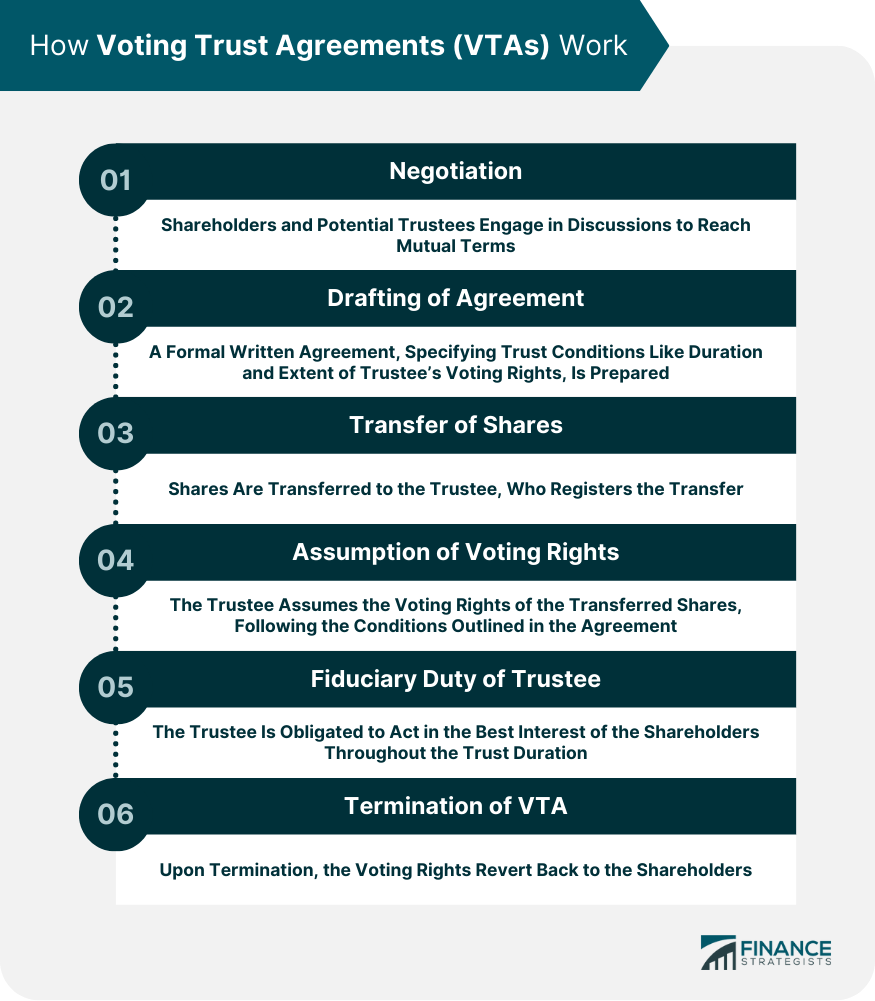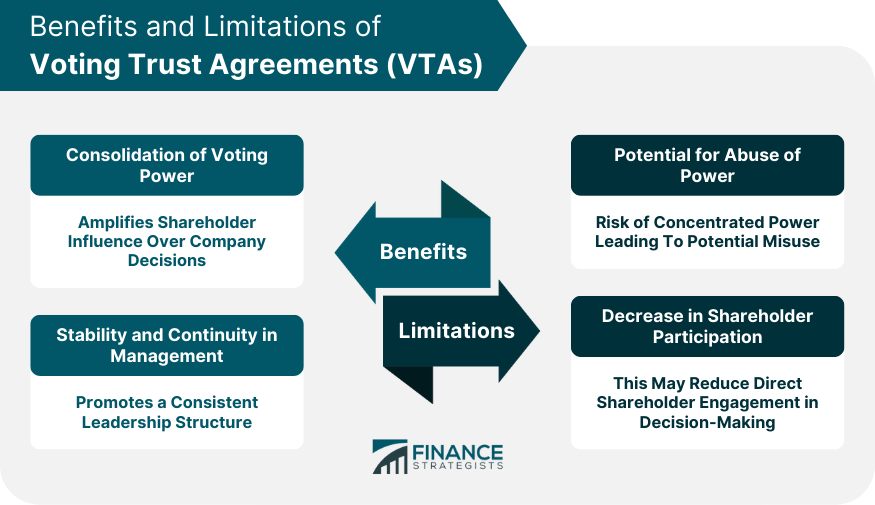Voting Trust Agreements (VTAs) are contractual arrangements between shareholders and trustees, assigning the voting rights of their shares to the trustees for a specified duration. The purpose of VTAs is to consolidate voting power, often to facilitate control, streamline decision-making, or protect a company's strategic direction. VTAs directly impact shareholders, as their voting influence is temporarily transferred, potentially affecting company management and policies. In contexts such as corporate governance, mergers, or acquisitions, VTAs are critical tools. They can influence the balance of power and ensure stability during transitions. However, they also bear the risk of potential misuse by trustees, underscoring the importance of carefully drafted agreements. Understanding VTAs is essential for shareholders and business leaders in navigating the complexities of corporate governance and protecting their interests. VTAs are legal arrangements wherein shareholders voluntarily transfer their voting rights to a trustee for a specified period. The creation process involves several steps. First, negotiations occur between the shareholders and the potential trustee. Once terms are agreed upon, a formal written agreement is drafted detailing the trust's conditions, including its duration and the extent of the trustee's voting rights. The shares are then transferred to the trustee, who registers the transfer. From this point, the trustee assumes the voting rights of the transferred shares, using them as stipulated in the agreement. The trustee holds a fiduciary duty, meaning they are obligated to act in the best interest of the shareholders. Upon termination of the VTA, the voting rights revert to the shareholders. VTAs provide a mechanism for consolidating voting power and ensuring stable company management. Creating a VTA requires a formal written agreement, transfer of shares to the trustee, and registration of the transfer. The contract must detail the terms of the trust, including its duration and the trustee's voting rights. In the United States, VTAs are governed by state corporate laws. For instance, the Delaware General Corporation Law is often applied due to its favorable terms. Internationally, VTAs must comply with the corporate laws of the respective countries. Different jurisdictions have varying laws regarding VTAs. In some countries, these agreements are strictly regulated to prevent misuse, while others have more lenient laws to promote business flexibility. The creation of a VTA involves several steps, from the initial negotiations between the shareholders and the potential trustee, drafting the agreement, to the transfer of shares to the trustee. The voting trustee holds a fiduciary duty to the shareholders. They are obligated to act in the best interests of the shareholders and exercise their voting rights as per the agreement's terms. Once the VTA is in place, the trustee assumes the voting rights of the transferred shares. They can vote on these shares as per the terms outlined in the VTA. The duration of a VTA is typically defined in the agreement. Upon termination, the voting rights revert back to the shareholders. One of the primary benefits of VTAs lie in the potential for shareholders to amplify their influence over the company's governance. By collectively pooling their voting rights into a single trust, shareholders can leverage this consolidation to wield a more substantial impact on crucial corporate decisions. This process ensures that their voices aren't diluted and their interests have a strong representation in the company's trajectory. VTAs also play a vital role in fostering a stable and consistent leadership structure within a corporation. By shifting the control of voting rights to a single trustee, the likelihood of frequent changes or unpredictability in management is reduced. This strategic pooling of voting rights helps maintain continuity, especially in times of leadership transitions or uncertain market conditions, thereby promoting long-term business stability. While the consolidation of voting rights presents significant advantages, it also poses potential risks. Critics argue that VTAs may inadvertently create a concentration of power within the trustee's hands. This structure, if unchecked, could lead to misuse or decisions that may not necessarily reflect the diverse interests of all shareholders. This potential for overreach necessitates careful consideration when selecting trustees and drafting the terms of the agreement. Furthermore, VTAs may contribute to a reduction in direct shareholder participation in the decision-making processes of the company. Since shareholders delegate their voting rights to the trustee, they may feel somewhat removed from the day-to-day governance of the company. While this doesn't necessarily negate their influence—since the trustee acts on their behalf—it does change the dynamic of shareholder engagement. This shift calls for a balanced approach to ensure shareholders continue to feel engaged and invested in the company's performance and direction. VTAs can be used as a defensive measure against hostile takeovers by consolidating voting power with a trusted entity. Influence on the Board of Directors: By controlling a significant portion of the voting power, the trustee can influence the Board of Directors considerably. Role in Decision Making and Strategic Planning: The trustee, through the VTA, can influence major company decisions and strategic planning by exercising the voting rights they control. Voting Trust Agreements (VTAs) offer an effective tool for consolidating voting power, ensuring stability, and streamlining decision-making in corporate governance. These legal arrangements transfer shareholders' voting rights to a trustee, amplifying their collective influence and fostering consistent leadership. Despite their benefits, VTAs bear potential risks, such as concentration of power and diminished shareholder participation, necessitating prudently drafted agreements and careful trustee selection. They have diverse applications, notably in defense against hostile takeovers and influencing board decisions. VTAs' future appears promising, with technologies like blockchain expected to enhance transparency and security. While their use is likely to continue due to their integral role in corporate governance, the anticipation is for more robust regulations to address the potential for misuse. Thus, understanding VTAs is crucial for shareholders and business leaders in navigating corporate governance complexities.Voting Trust Agreements (VTAs) Overview
How VTAs Work

Legal Framework of VTAs
Legal Requirements for Formation of VTAs
Legislation Governing VTAs
International Variations and Comparison in VTA Law
Mechanism of VTAs
Creation of VTAs
Roles and Responsibilities of the Voting Trustee
Transfer of Voting Rights and Benefits to Trustee
Duration and Termination of VTAs
Benefits and Limitations of VTAs
Benefits of Using VTAs
Amplification Through Consolidation of Voting Power
Ensuring Stability and Promoting Continuity in Management
Limitations and Criticisms of VTAs
Risk of Concentrated Power and Potential Misuse
Diminishing Direct Shareholder Participation

Use of VTAs in Takeover Defenses
Bottom Line
Voting Trust Agreements (VTAs) FAQs
VTAs are legally binding contracts that transfer the voting rights of shareholders to a trustee. They're crucial in corporate finance because they provide stability, consolidate influence, and mitigate potential conflicts of interest, especially in situations where decisive action is required.
The formation of a VTA requires a formal written agreement, the transfer of shares to the trustee, and registration of the transfer. The agreement must include the terms of the trust, such as the trustee's voting rights and the duration of the trust.
The trustee in a VTA assumes a fiduciary duty to act in the best interests of the shareholders. They are obligated to exercise the voting rights of the transferred shares according to the terms outlined in the agreement.
The main advantages of VTAs include consolidation of voting power and stability in management. However, they have potential downsides, like the risk of abuse of power by the trustee and a decrease in shareholder participation in company decision-making.
VTAs play a significant role in mergers and acquisitions. They can provide stability during corporate restructuring and can also be used as a defensive measure against hostile takeovers by consolidating voting power with a trusted entity.
True Tamplin is a published author, public speaker, CEO of UpDigital, and founder of Finance Strategists.
True is a Certified Educator in Personal Finance (CEPF®), author of The Handy Financial Ratios Guide, a member of the Society for Advancing Business Editing and Writing, contributes to his financial education site, Finance Strategists, and has spoken to various financial communities such as the CFA Institute, as well as university students like his Alma mater, Biola University, where he received a bachelor of science in business and data analytics.
To learn more about True, visit his personal website or view his author profiles on Amazon, Nasdaq and Forbes.











